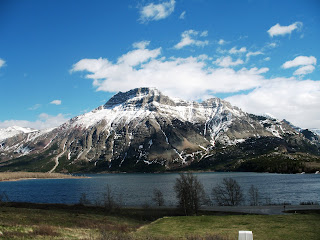 Just a few miles west of Cardston, Alberta, Canada is Canada's fourth national park - Waterton Lakes National Park. This park was formed in 1895 and was named after Waterton Lake. It borders the US and Glacier National Park in Montana. The park covers about 200 square miles of rugged mountains and wilderness.
Just a few miles west of Cardston, Alberta, Canada is Canada's fourth national park - Waterton Lakes National Park. This park was formed in 1895 and was named after Waterton Lake. It borders the US and Glacier National Park in Montana. The park covers about 200 square miles of rugged mountains and wilderness.The park is very diverse for its size having prairie, apsen and alpine forests, tundra and high meadows. The primary feature of this park is Waterton Lake, the deepest in the Canadian Rockies. The peak to the right is Vimy.

To the right is the Prince of Wales Hotel, notebly, one of the nost photographed hotels in North America. The hotel is set on a bluff above Waterton Lake. The hotel apparently offers a true British experience including an afternoon tea. We were not able to enter and look around as it was under renovation.
 The wildlife is abundant! Just about everywhere in the park, wildlife strolled like pedestrians. There are over 60 species of mammals, 250 species of birds, 24 species of fish and nearly a dozen types of reptiles.
The wildlife is abundant! Just about everywhere in the park, wildlife strolled like pedestrians. There are over 60 species of mammals, 250 species of birds, 24 species of fish and nearly a dozen types of reptiles.Apparently, this park, in conjunction with Glacier National park to the south, is a extremely important wildlife corridor. A number of differnet ecological regions that meet and overlap in the park. According to one web site, the park contains 45 different habitats within 200 square miles.
 Cameron Falls is located in the townsite of Waterton. The setting is restful and inspiring. Some of the exposed rock around the falls site can be dated back to precambrian time; about 1.5 billion years ago. The power of water on geology is very evident. Wait long enough and water will wear you down!
Cameron Falls is located in the townsite of Waterton. The setting is restful and inspiring. Some of the exposed rock around the falls site can be dated back to precambrian time; about 1.5 billion years ago. The power of water on geology is very evident. Wait long enough and water will wear you down!
These mountains are some of the oldest mountains in North America. An incredible example of fault block effect. The peak in this picture is Aldersen Peak. In the foreground is another view of the Prince of Wales Hotel.
Can you imagine having afternoon tea (herbal) in the hotel while looking out at this peak and the lake?

Another look at Aldersen Peak in the middle flanked by sister peaks.
A picture of Red Rock Canyon. On a small scale, it has a Sedona, AZ feel. The rock coloring is very similar. The canyon is set among the alpine meadows and jagged mountain peaks. We did not explore this canyon much in that we were short on time. If we had more time we could have hiked a short distance to Blakison Falls. The peak in the background is Dungarvin Peak.
This is one park that we will come back to see again.

1 comment:
Waterton Lakes National Park is open year round. The best time to visit though is during July and August. The park is one of Alberta’s warmest places in the winter, despite temperatures that can drop as low as -40*C.
Waterton lakes national park wildlife
Post a Comment